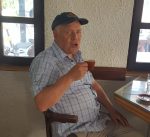Saint Petersburg & The Baltic
August 14th, 2017A Baltic adventure
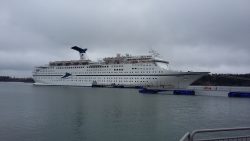
The Magellan
I have never been on a cruise before but this is the opportunity to explore Copenhagen, Rostock and Warnemunde (Germany), Tallinn, Helsinki, Stockholm and St. Petersburg. All will be new places, except for Copenhagen which I have visited twice before. I am excited about visiting new countries such as Russia and Finland with very contrasting cultures but a surprising overlapping history. Will my prejudices about cruises be confirmed? Or will I be surprised by the hidden delights of this form of travel?
This is the cruise ship Magellan. It will be my home for the next two weeks along with about 1300 other passengers. We depart Tilbury London and head for the North Sea and Copenhagen. Our bedroom is one of the ‘cheaper’ cabins; so no window or the luxury of a balcony. Personally this doesn’t bother me as I intend to spend as little time as possible in the cabin. It is however reasonably spacious and comfortable.
The ship itself has a library, a Spa facility (including Jacuzzi and steam room), entertainment area, outdoor swimming pool and the usual bar and restaurant facilities. I mention the Jacuzzi and steam room as this is part of a section of the boat where you do have to pay for treatments such as a massage. However I discover the Jacuzzi and steam room are free to use. Most passengers are seemingly unaware of this. I therefore use these whenever I can when we are not in port. I soon learn this is a place to help tired limbs recuperate.
Dining out in style
The dining facilities can be quite formal with a suit or evening dress required if you attend dinner with the captain in attendance. Older guests, in particular, like the formal dining. However informal dining is more to my liking and the food served is equally tasty with healthy options if you prefer. It seems more relaxed to eat just wearing your shorts and T shirt. The temptation is to eat too much. Our companions on the first evening are seasoned cruisers. He has spent most of his career in the RAF and enjoys wearing his military tie at dinner. They are in their mid eighties and the attraction of a safe environment to travel in is understandably very attractive.
Navigating Copenhagen in a wheelchair
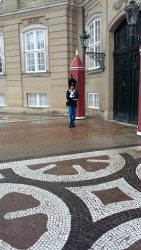
Amalienborg – Royal Palace
After nearly two days of sea travel we arrive in Copenhagen. We have opted for a guided tour. Unfortunately it is a wet and relatively cold day. The guide is excellent in explaining the history of the city but we don’t see Copenhagen at its best. The rain seems to make it a drab place. I have previously visited in the sunshine and sat by the canal eating my herring and found it an enchanting city. One lady falls over, tripping over a kerb, but she recovers from the fall seemingly without any injury. She is, in fact, escorting her husband in a wheelchair. There are a number of passengers with some form of disability requiring a walking stick or wheelchair to get around. They don’t seem daunted by these restrictions and fully participate in the onshore excursions.
The Danish resistance fighters
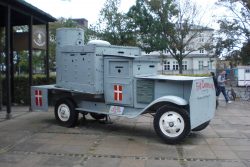
Resistance Museum
On a previous visit to Copenhagen I visited ‘The Former Resistance Museum’ – visit website. It tells the story of resistance fighters in the Second World War. Officially Denmark was neutral in World War 11 but occupied by German troops. However a number of Danish resistance fighters were captured. The letters of these fighters to their mothers are on display. It describes their thoughts and feelings prior to execution. It is one of the most moving things I have read. Their words are so vivid you are almost transported to their prison cells and to the homes of the mothers as they read their sons’ last words. Unfortunately the museum is closed, due to fire. The damage to the building was so bad it had to be destroyed. A new building is due to be built by 2019. However all the archives have been saved and can be seen but you need to make a prior appointment. If you are in Copenhagen it is an opportunity not to be missed.
Who was the model?
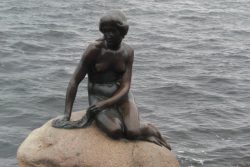
The Mermaid
Probably the most popular attraction in Copenhagen is the bronze statue of The Mermaid. It can be found on the Langeline promenade by the waterside. The person who did the sculpture is Edvard Eriksen. There is a delightful story behind the sculpture. Edvard went to the opera and he saw a beautiful woman who he asked to be the model for The Mermaid. She agreed to model for the head but not the body. In fact the model for the body of The Mermaid is his wife.
Where is Warnemunde?
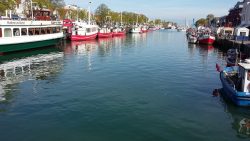
River Warnow
The following day we find ourselves in the port of Warnemunde in Germany. Before the Berlin Wall came down it was part of East Germany. 700,000 tourists a year visit this pretty town which shows the popularity of cruising today. Many cruise ship passengers use it as a train link to visit Berlin. The impression as you walk around is the place is geared up for German tourists. However overseas visitors who just use it as a stopping off point for somewhere else are missing a treat. It has lovely clean beaches and sights such as the windmill and the Unesco world heritage lighthouse.
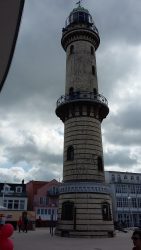
Warnemunde lighthouse
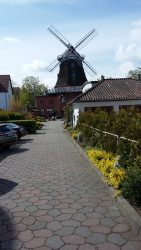
Warnemunde windmill
What I liked about it is you can stay until late evening eating and drinking without worrying about returning to the boat. Most other places you only had a few hours to visit or, in the case of St Petersburg, be part of an organised tour. There are also regular boat trips along the river including to the nearby town of Rostock
Rostock revealed
There are frequent trains from Warnemunde to Rostock which only take a few minutes. This is the regional capital with a population of just over 200,000 people. A more fun way of travelling is a boat ride on the River Warnow which takes 45 minutes. For me the main attraction is the thirteenth century church Marienkirche. It is the only main church in Rostock to survive WWII unscathed.
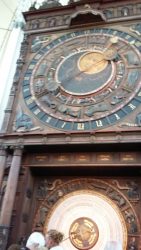
Astrological clock inside Marienkirche
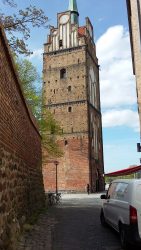
13th century church Marienkirche in Rostock
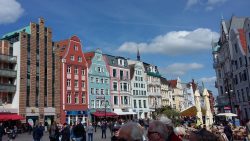
Rostock centre
Inside Marienkirche is the astrological clock built in 1472 by Hans Duringer. It truly is a masterpiece of engineering. At noon and midnight the inner most right doors situated at the top of the clock open. Six of the twelve apostles march out to parade around Jesus (Judas is locked out). The clock is the only one in the world still with original mechanism.
Brexit and Communism
Our guide for the day is a relatively young man in his mid 30’s. He describes, in perfect English, how different generations view living in Rostock today. His grandparents’ generation tend to yearn for the security of the days of Communist rule when jobs and homes were almost guaranteed, although they were probably less well off. Even some of his parents’ generation are nostalgic for these times. His own generation prefer the opportunities to work and travel under the current regime. In many ways I thought it was also reflecting how many people were motivated to vote in the EU referendum in the UK.
The red roofs of Talinn
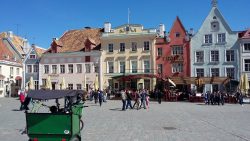
Main square Talinn
We have made our way north through The Baltic and arrived in Tallinn the capital city of Estonia.
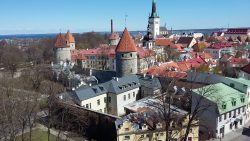
The red roofs of Talinn
It is a city that surprised me. It has a very relaxed atmosphere and a proud feeling of independence from its more powerful neighbour Russia. It also values its membership of the EU and is the inventor of Skype. What I had not realised is it has introduced online voting in national elections. There is no doubt this encourages more young people to vote. For some reason however this has not been adopted by other western democracies. If they did it would surely change the political makeup of most of these countries. Perhaps this is why it has not happened!
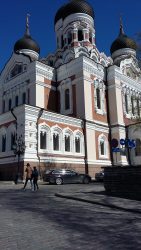
Alexander Nevsky Russian Orthodox Cathedral
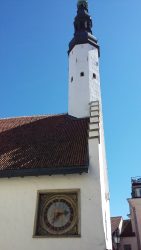
13th century Cathedral of St Mary Taliin
It is also a place to enjoy homemade beers and local beers produced in micro breweries. In the delightful Old Town there are medieval wine cellars and lots of bars where you can enjoy Estonian beer.
The city has very contrasting architecture and includes the Alexander Nevsky Russian Orthodox Cathedral and the medieval walls of the lower part of the Old Town. It is an easy place to explore on foot along cobblestone streets and gentle slopes. I would definitely re-visit as there is more than enough to occupy you over a long weekend.
The splendour of St Petersburg
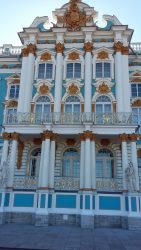
Catherine Palace St Petersburg
And so we arrive in the magnificent city of St Petersburg. Let me start with an amusing story, although not so for the person who found himself at the centre of this intrigue. One of the passenger’s on the ship decided when he went ashore to visit a jewelers shop. Unfortunately as he entered the shop he tripped over the step and crashed into one of the cabinets. The cabinet then exploded and he was arrested for attempted burglary. The first police who arrived said it was outside their jurisdiction but he was detained and taken to a local police station. One and a half hours later he was released having convinced the police that it was only an accident. It must have been a very unnerving incident for the passenger who was probably far more upset than the owner of the shop. It only begs the question what would have been the outcome if he had been an independent tourist rather than as part of an organised tour. The guide to the tour acting as an effective advocate for the tourist.
Russian history
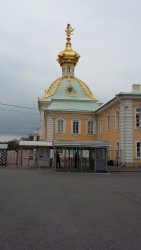
Gatehouse at Catherine Palace
One of the hidden delights of the cruise was a brilliant series of lectures on Russian history. These were delivered whilst we were travelling between ports and very much added to my understanding of the historical context of St Petersburg. To say Russian history is packed with intrigue and treachery is an understatement. It soon became apparent how good the talks were and the theatre was packed each time he presented. He was then asked to deliver additional sessions; no doubt by popular request. Unfortunately I cannot remember his name to give him the credit he deserves.
Gold and more gold
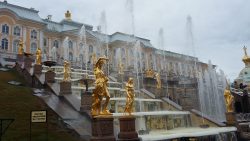
Fountains at Peterhof Palace gardens
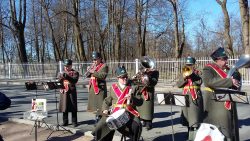
Russian band outside Peterhof Palace
There is a lot of gold in the museums and palaces of St Petersburg. The abundance of gold statues in the grounds of Peterhof Palace, the golden onion domes of the Chapel of Catherine Palace and the Gold Rooms of the Hermitage Museum are just three examples. I must admit I found it a bit overwhelming. How could a ‘Communist’ state spend so much money on these edifices when so many of the local citizens were living in relative poverty? There did seem a little irony here. This is not to ignore the delights of St Petersburg architecture such as the estate of the Peterhof Palace with its wonderful fountains and Grand Cascade. What I particularly liked was the display of local traditions such as the band playing outside Peterhof Palace.
Who would be a painter?
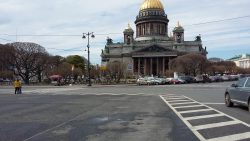
St Isaac’s Cathedral, St Petersburg, (Isaakievskii sobor)
One of the key landmarks in St Petersburg is St Isaac’s Cathedral nearby to the River Neva. It is the fourth highest cathedral in the world. As with the building of so many of the major edifices in the world there is a significant cost, not only in money but also the lives of those who are involved in the construction. Many serf labourers fell to their death or from the inhalation of mercury. Even the painter Karl Briullov, who was responsible for creating the designs on the ceiling fell ill and died
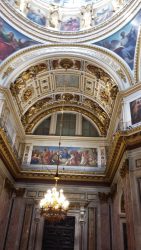
Inside St Isaac’s Cathedral
three years later. He retired to Madeira and later to Italy. Can you imagine the stress of working for hours on end so high up on scaffolding painting the ‘Plafond’ (ceiling). Inside the cathedral is an impressive space, which can accommodate 14,000 worshipers. I must admit I am not a great fan of religious icons in churches but somehow you have to admire the labour of love that goes into creating these images such as the Adam and Eve picture in St Isaacs Cathedral.
What I do find fascinating is the internal and external architecture of religious buildings. You can know almost immediately if a building is in the tradition of Christianity, Muslim, Hindu or Buddhist. Even within these religions there are distinct differences. On this travel tour it was always evident which churches or cathedrals were Protestant or Catholic. There is a simplicity about Protestant churches, particularly those with a Lutheran influence. Whereas Catholic churches are much more ornate and often using expensive materials such as gold.
Everyday life in St Petersburg
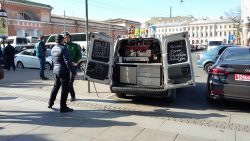
Selling food & drink from van, St Petersburg
One of the challenges of visiting St Petersburg as part of an organised tour is to have a flavour of how local folk live. The Peterhof Palace and gardens are situated many miles outside of the city so from inside your coach you observe the flats and houses that local people live in on your journey to the palace. The flats seem in good condition and well maintained if a little austere in their architecture. The houses in the suburbs and villages outside the city are pretty and a little more affluent in their setting.
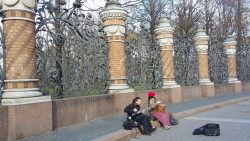
Buskers in St Persburg
Local people find innovative ways of making a living such as selling food and drink from the back of a van. Others earn a
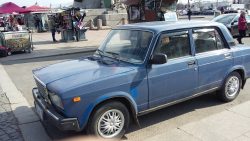
Iconic Trabant car in St Petersburg
little money by busking near well known monuments. I visit a local shop to buy some souvenirs. The sales assistant speaks perfect English and asks where I am from. When he discovers I am from Nottingham he immediately starts to talk about Nottingham Forest. Even though their glory days in Europe are from the 1970’s, probably before he was born. In many ways it is not so different from any other city in Europe. However it does seem a little more ‘controlled’ and less relaxed than a Berlin, Budapest or Paris.
Hermitage Museum
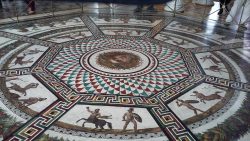
Inside the Hermitage Museum
The Hermitage Museum is the biggest collection of art works in the world. It is so popular with overseas visitors and with Russians that inevitably you do find yourself waiting in a queue to gain entry, even if the visit is booked in advance. I felt as if I was in continuous bus queue as we walked around the museum which somehow distracted you from the paintings and sculptures. There is too much to see in an allotted time of two hours. Those who visited in the evening as opposed to the day time described a much more relaxed and enjoyable experience. The guide also described how so many of the art treasures had to be hidden in World War II or transported to Moscow. A lot of this was done by the women, as the men were away fighting. It seems that they were very successful as most of the art works survived the Nazis invasion.
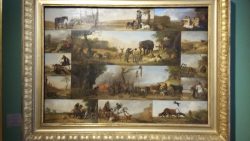
‘The Hunter and Hunted’, the Hermitage Museum
My favourite picture in the Hermitage Museum is of ‘The Hunter and the Hunted’. The hunter finally gets his comeuppance as he is attacked by the animals. It is nice to think that the vulnerable finally win and their oppressor (the hunter) receives his just desserts. Unfortunately in real life this is not always the case.
Discovering Clowberry Jam in Helsinki
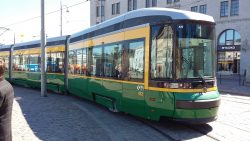
A tram in Helsinki
We arrive in Helsinki several hours late as the ship had engine problems in St Petersburg and we
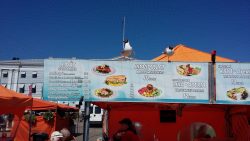
Seagulls at market in Helsinki
were therefore delayed in leaving the Russian port. We had planned a visit to a Finnish fishing village but there was now only time to visit Helsinki.
In many ways Helsinki was my favourite city on the trip. It had lovely clean air and a local market by the waterside. I bought a jar of Clowberry jam which had been harvested in northern Finland on the farm of the store holder. I had never previously heard of Clowberry; it has a very light taste and is not as sweet as say the strawberry jam we eat in England. The only downside was the price of a pint of beer 18.5 Euro. I suspect this probably includes a ‘heavy’ tax to discourage excess drinking. The city is modern, but with some traditional architecture, very welcoming and with an international feel to it. It would also be possible to visit here from the UK by air stay a few days and then catch a short ferry to Tallinn and fly back from that city.
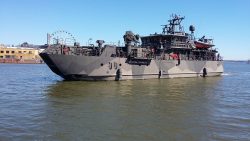
Naval ship in Helsinki port
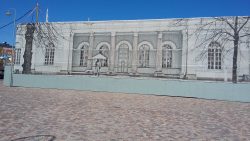
Street art in Helsinki
I take a picture of some street art on one of the walls of a building near to the centre of of the city.It is vaguely familiar but still have not discovered who the artist is. There are also seagulls swooping down onto unsuspecting tourists to steal their fish and chips. We had observed something very similar in Warnemunde. They are much more aggressive than any bird I have seen at an English seaside place.
The attractions of cruise travel
At breakfast and lunchtime I chat to other passengers and most are seasoned ‘cruisers’. There are a number of ladies travelling on their own or with a female friend. For some it is because their husbands have died or their partners are at home too ill to travel. Some are also travelling and are unwell. One man travelling with his wife was suffering from cancer and had paid travel insurance of £1500. They were a minority but well catered for and seemed to thrive in this environment. There was live entertainment every evening including comedians and tributes to various musical decades. The Abba songs were good fun but The Carpenters are not quite to my taste. I while away the hours reading or attending ‘talks’; others play board games and table tennis or attend a quiz.
Our final destination of Stockholm
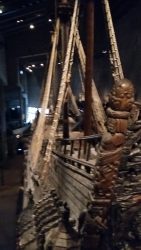
Warship inside Vasa Museum in Stockholm
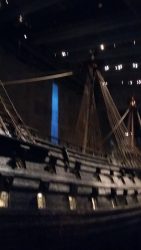
Salvaged 17th century warship inside Vasa Museum
We arrive at our final destination of Stockholm via the port of Nynashamn. It is raining for most of the day so I don’t think we see the capital of Sweden at its best. The highlight for me is a visit to the Vasa Museum. It houses a 17th century warship which sank in Stockholm’s inner harbour on its maiden voyage in 1628. Its discovery in 1956 and subsequent salvage in 1961 is an amazing story. It is remarkably well preserved and still contains original sculptures and canons. It is a marine story which I had been completely unaware of.
Somehow we are not taught at school historical incidents that do not directly impinge on our own country. The design of the ship is not broad enough at the base to ensure the stability of the ship. The king also persuades the designer to put many more canons on the boat and the structure of the boat cannot cope with their weight. It sank soon after it hit the water and many sailors lost their lives. Strangely no one was held accountable for this tragedy. It is not unlike many modern day disasters where the perpetrators are too important to be held responsible.
